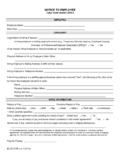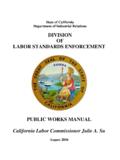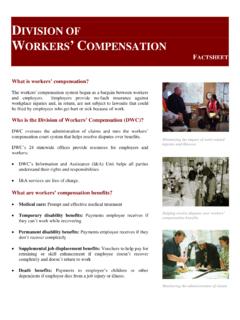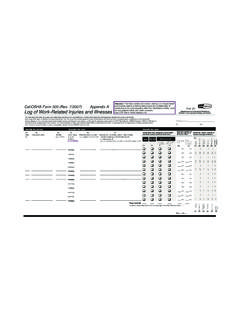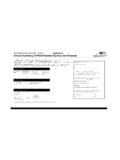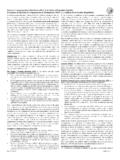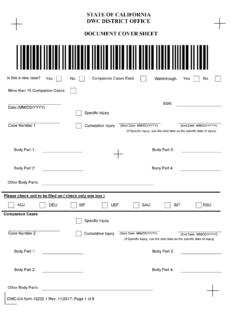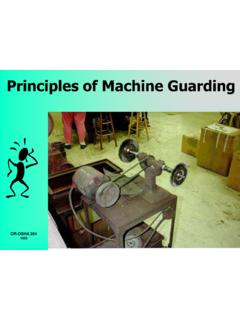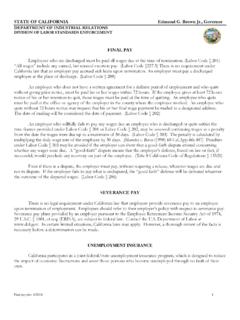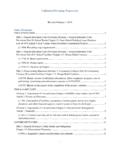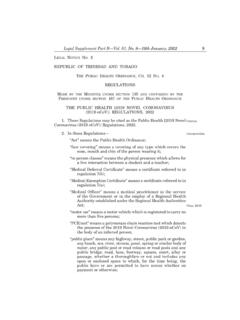Transcription of COVID-19 Emergency Temporary Standards Frequently Asked ...
1 COVID-19 Emergency Temporary Standards Frequently Asked Questions Updated June 18, 2021. On June 17, 2021, the Occupational Safety and Health Standards Board ( Standards Board) voted to update the COVID-19 Emergency Temporary Standards (ETS), 8 CCR Executive Order N-09-21 permitted the revised ETS to take effect the same day. The below FAQs address the June 17, 2021 revision of the ETS. You may also refer to this shorter set of FAQs that highlight the changes between the original November 30, 2020 ETS and the revised ETS. Please note: At the bottom of this webpage, you will find footnotes that describe what updates have been made. Table of Contents Scope of Coverage The COVID-19 Prevention Program Communication with Employees Identifying, Evaluating and Correcting COVID-19 Hazards Face Coverings and Other Controls Ventilation Vaccines Training Addressing COVID-19 Cases in the Workplace Testing Outbreaks Exclusion Pay and Benefits Waivers of Exclusion Requirements Based on Community Health and Safety Recordkeeping and Reporting Additional Resources FAQ Revision and Updates Scope of Coverage Back to top 1.
2 Q: Which employers must comply with the COVID-19 Emergency Temporary Standards (ETS)? A: The ETS applies to all employers, employees, and to all places of employment with the following exceptions: o Work locations where there is only one employee who does not have contact with other people. o Employees who are working from home. o Employees who are covered by the Aerosol Transmissible Diseases regulation. o Employees working from a location chosen by the employee , which is not under the control of the employer (for instance, an employee teleworking from a caf or a friend's home). 2. Q: Does the ETS apply for employees who split their work time between home and the workplace? A: Yes, however, the regulation applies only when employees work at the workplace, or are exposed at work, but not when they work from home.
3 3. Q: Does the regulation apply to workplaces with only one employee who has brief contact with other persons? A: Yes, the regulation applies to such workplaces (unless they fall into one of the exceptions listed above); however, the measures that the employer must implement to comply with the ETS will reflect this type of limited exposure. 4. Q: Does the regulation apply for employees who are working from remote locations other than their home? A: No, the regulations do not apply to employees an employer assigns to telework but who choose to work elsewhere, such as at a hotel or rental property. The regulation on employer-provided housing ( ) applies when a person is working from a hotel arranged for or provided by the employer;. however, the rule does not apply to business travel by employees unless they are sharing a room or suite.
4 5. Q: Does the regulation apply to any facility that is subject to the Aerosol Transmissible Diseases (ATD) standard? A: The ETS applies to employees at these facilities who are not identified in the employer's Aerosol Transmissible Diseases Exposure Control Plan, as required under California's Aerosol Transmissible Diseases (ATD) standard (8. CCR section 5199), as having occupational exposure to aerosol transmissible diseases, such as administrative employees who work only in an office environment separated from patient care facilities. 6. Q: The regulation exempts employees with occupational exposure as defined by section 5199, when covered by that section. Can an employee in a single workplace be subject to both the ETS and section 5199 at different times? A: No. In a facility or operation that is within the scope of section 5199, employees with occupational exposure to aerosol transmissible diseases (ATDs), as defined in section 5199, are covered by the requirements of section 5199, and not the ETS.
5 This is true even when an employee who has occupational exposure performs tasks that do not include exposure to ATDs, , when a hospital nurse who performs patient care spends time in the hospital's human resources office. 7. Q: Can an employer at a workplace covered by section 5199 deem all employees on site to have occupational exposure to COVID-19 and exempt them from the ETS? A: If the employer provides all employees with protections under its ATD. Exposure Control Plan and has incorporated those employees into the plan in accordance with section 5199 because they have an occupational exposure to COVID-19 , then those employees would not be subject to the ETS. 8. Q: The regulation exempts employees with occupational exposure as defined by section 5199, when covered by that section. Can a firefighter be subject to both the ETS and section 5199 at different times?
6 A: No, a firefighter cannot be subject to both the ETS and section 5199. However, a firefighter must be protected from COVID-19 under one of the Standards . If the firefighter performs Emergency medical services (EMS) duties, such as those of a paramedic, Emergency medical technician or first responder; or if the firefighter otherwise provides support in the field to those performing EMS. duties, the firefighter has occupational exposure to aerosol transmissible diseases (ATDs), as defined in section 5199, and is covered by the requirements of section 5199, and not the ETS. This is true even when that firefighter performs tasks that do not necessarily involve potential exposure to ATDs, , when responding to non-EMS calls and when otherwise traveling in fire department vehicles; when performing routine tasks, such as training and maintenance; and while engaged in the normal routines of a fire station, including meals and sleeping.
7 Section 5199(e) requires employers to use feasible engineering and work practice controls to minimize employee exposures to aerosol transmissible pathogens. This includes implementing COVID-19 protections in fire department vehicles and facilities, such as by improving ventilation, physical distancing and mask use in accordance with CDPH requirements, including in facility sleeping quarters and other common areas. Under Section 5199(h)(6)-(9), covered employers must implement specific follow-up requirements in the event an employee is exposed to an aerosol transmissible pathogen. This includes fire departments when firefighters are potentially exposed to COVID-19 , regardless of the source of the exposure. If a firefighter is not identified as having occupational exposures to ATDs in the employer's ATD Prevention Plan or if a firefighter is not protected under that plan, the firefighter would be subject to the ETS.
8 The COVID-19 Prevention Program Back to top 1. Q: What are the main requirements of the ETS? A: To comply with the ETS, an employer must develop a written COVID-19 . Prevention Program or ensure its elements are included in an existing Injury and Illness Prevention Program (IIPP). The employer must do the following in accordance with their written program: o Communicate to employees about the employer's COVID-19 . prevention procedures. o Identify, evaluate and correct COVID-19 hazards. o Require and provide face coverings and respirators in the manner and in the circumstances specified in the ETS. o Advise employees they can wear face coverings at work, regardless of their vaccination status, without fear of retaliation by the employer. o Use engineering controls, administrative controls and personal protective equipment under certain circumstances.
9 O Follow procedures to investigate and respond to COVID-19 cases in the workplace. o Provide COVID-19 training to employees. o Make testing available at no cost to employees who have had a close contact (as defined in the ETS) with a person with COVID-19 , and in the case of multiple infections or a major outbreak, make testing available at no cost on a regular basis for employees in the exposed work areas. This requirement does not apply to exposed employees who are fully vaccinated and have no symptoms, except during major outbreaks. o Exclude COVID-19 cases and exposed employees from the workplace until they are no longer an infection risk. Exposed employees who are fully vaccinated and have no symptoms do not need to be excluded. o Follow return to work criteria. o Maintain records of COVID-19 cases, and report serious illnesses to Cal/OSHA and to the local health department when required.
10 Cal/OSHA has posted a Model COVID-19 Prevention Program on its website for employers to use. Communication with Employees Back to top 1. Q: What does the ETS require employers to communicate to employees? A: Requirements include: o How to report COVID-19 symptoms, possible close contacts and hazards to the employer without fear of reprisal o COVID-19 hazards in the workplace and the employer's policies and procedures to address them o Best practices for preventing the transmission of COVID-19 , including information on respirators o When and how unvaccinated persons can request a respirator o That employees may wear face coverings at work, regardless of their vaccination status, without fear of retaliation by their employer o How employees with elevated risk factors for COVID-19 , which can be found on the CDC's website, can request accommodations from their employer o How the employee can obtain testing for COVID-19 , such as through the employer's workplace-based testing program, or through the local health department, a health plan.
